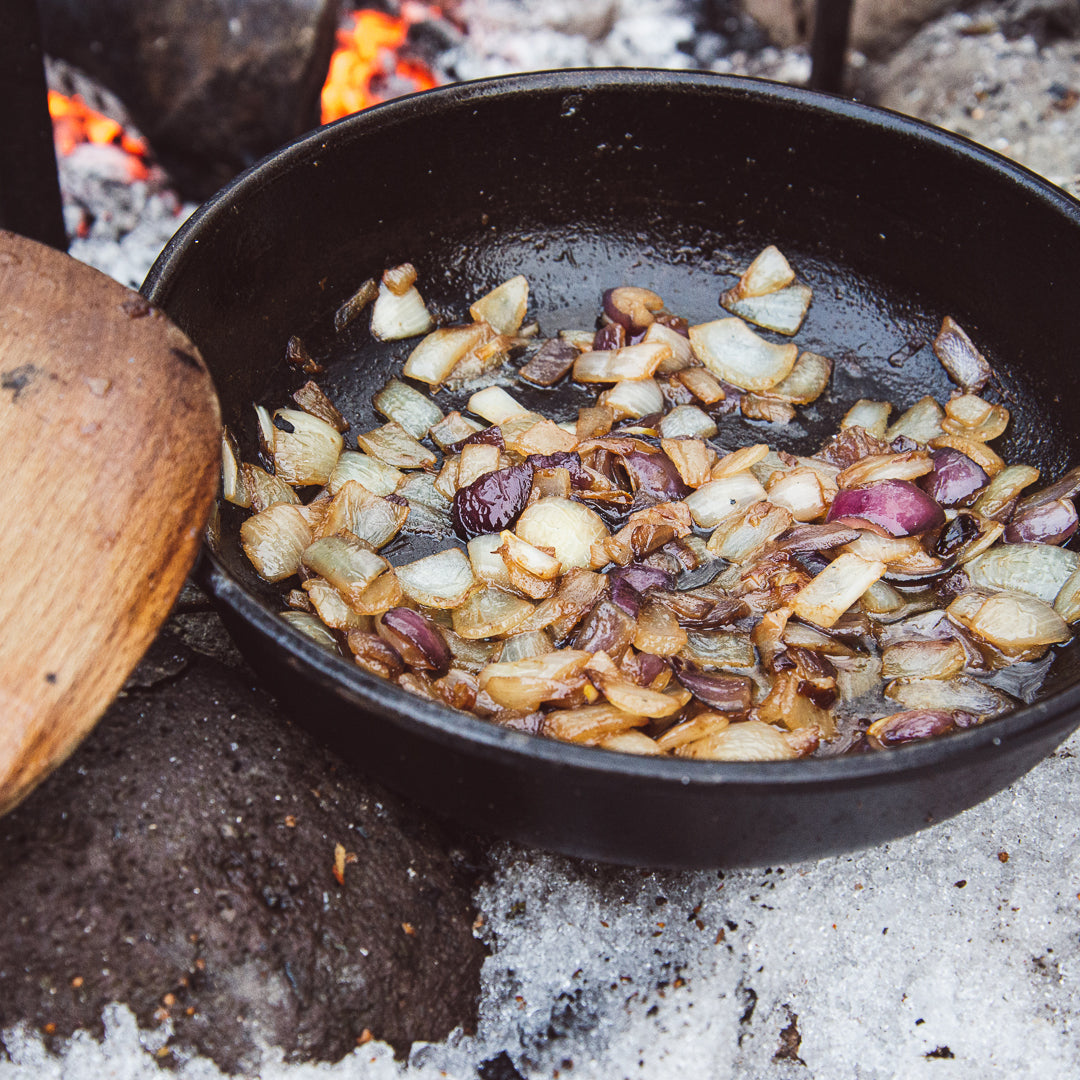
Browned sautéed onions. The underdog of ingredients and process in most delectable dishes. Taking no more than ten minutes and sitting at next to no cost in the raw material department who gives a fuck about sauté onions?
After all, they will be masked by all other noteworthy ingredients which comprise the main flavours of the dish and never did you hear of world class chef’s earning their way to the onion peeling station. It’s a shit job. By the time you’ve peeled a 20kg sac, you’ve lost your weight in tears and you walk around the kitchen permanently smelling like that guy who skipped on deodorant before the shift. I digress….
Growing up I watched the cooks in our family kick off most dishes with onions being browned by sautéing. There was no discussion around why this step happened, it’s just what you did. That’s how most Persian kitchens operate. Even though my mom and grandma made the process look so casual, as if they could perform it in their sleep; we all knew that the ceremonious browning of ingredients was the cardinal, generally, first step to the delicious, flavourful dishes they would create. It set the tone. In fact, there was an understanding around browning ingredients in our families kitchen and it generally went something like, “you fuck this up and you’re out.” In the case of browning onions, they would get the oil in the pan nice and hot and then grab their terribly dull paring knife (which was their knife for all jobs) and cut the onion directly into the piping hot pan. Oil would start crackling and before they could even put down the dull blade, they would grab the turmeric stained wooden spoon and spread the onion out in the pan. Then they would do all sorts of unrelated tasks such as sitting down and having a sip of chai while catching a bit of their fave 90’s soap opera, all while maintaining this perfect nonchalant demeanour that gave the impression that they didn’t give a flying fuck about them onions, then suddenly - whoosh! They were up, back in the kitchen, wooden spoon in hand, giving the onions a stir or two and then flame out. I only clued in as I got older that this seemingly random act of getting to the onions in time was actually a meticulous calculation performed by their precise and accurate internal clocks that they had developed. A whole body awareness that those onions were done. Perfectly browned. Exactly where they needed them before they moved on to the next step of the process. Before even seeing the deep brown colour, they knew from the aroma that had filled the house that they were getting near ready, and just by listening to the sounds coming from the pan which had morphed from a crackling to more of a hum they knew they were getting closer. This process rarely took longer than 10 minutes, and when the onions were done they were nicely browned, still retained shape and some texture and released an aroma that would get the salivary glands singing. It was this moment that us kids would start lingering around the kitchen and wondering what was on the menu. These old methods, traditions and processes that have influenced my own experience in the kitchen are somewhat of a histoire that I find interesting. So I thought it’s about darn time I learn a little bit more about why I sauté onions? More importantly, why it’s so important to not fuck it up?

Whether you’ve spent time pouring over books like Larousse Gastronomique (the technical encyclopedia on French cooking), working at the local taco takeaway shop, or preparing dinner for your family, you will have come across steps related to “sautéing/browning ingredients.” My basic understanding of sautéing aromatics, in this case, onions, is that it transforms it from a sulphurous, pungent substance to a less pungent one, with a more balanced aroma and a mellow sweet flavour. It’s not that the raw onion is less delicious than the sauté onion, it’s just different. Serves an entirely different purpose. Browned onions are also different to caramelized onions which are made by very slowly (1-2 hrs) cooking onions over low heat and stirring frequently so they become an even deep brown colour, soft in texture and delightfully sweet.
Well then, what’s so great about browning onions? I began to dig and my research led me to a fabulous food science concept known as the “Maillard reaction.” A phenomenon that occurs almost daily, it’s everywhere, in fact, we use it so often that it’s easy to forget it’s there but when it’s missing you’ll notice. It is a terribly complex concept that was originally coined by Louis Camille Maillard in a paper published in 1912 and involves the science of browning, aroma and flavour. In a nutshell the Maillard reaction is many small, simultaneous chemical reactions that occur when proteins and sugars in and on your food are transformed by heat, producing new flavours, aromas, and colours. What does this look like in our everyday lives? It’s the reaction that makes food more enticing to us humans. Practically speaking, we no longer find a hunk of raw cow particularly appetizing but if that same hunk of cow were to be cut into steaks and seared over a fire, we tend to follow our nose right to where that piece of meat is being cooked. Same can be said about a raw potato versus a golden and perfectly crisp roast potato. You’re catching my drift.

Breaking it down a little bit more with some rudimentary chemistry, that raw onion is composed of a basic set of building blocks: proteins, sugars and water. The Maillard reaction is what can happen to the proteins and sugars when heat and time are added to the equation. With the right amount of heat, moisture and time, those specific sugars and proteins splice like it ain’t nobodies business and the result is an increasingly complex array of flavour and aroma molecules, along with a darker colour. As far as heat goes, the Maillard reaction generally begins to occur above 285°F (140°C). Essentially, Maillard likes it hot. Not too hot. We don’t want to hit pyrolysis which is the food science term for burning the shit out of your food. It tastes like garbage and better yet is known to be carcinogenic. Instead, you want to dehydrate the surface of your ingredient thoroughly enough that the temperatures on that surface will begin to climb, to upwards of 300°F (149°C). At that point, the Maillard reaction kicks in and the characteristic brown colours will become visible which is all done in a very specific way: by rearranging amino acids and certain simple sugars, which then arrange themselves in rings and collections of rings that reflect light in such a way as to give the ingredient a brown colour. Trust me it’s far more complex than that, but you get the jist.
Now the Maillard reaction isn’t significant because of what happens to the colour of food but instead the nirvana-like state it brings about in the human olfactory system. Basically, this incestuous molecular orgy that takes place between the proteins (long chains of amino acids) and simple sugars, banging billions and trillions of times per second on the surface of food creates aromas and flavours that make humans go “yup, I want that in my belly.” This makes me wonder about my mom and grandma and this internal clock I was discussing earlier. How much of it was them refining and mastering the craft of cooking, and how much of it was them tuning in and listening to their own bodies say, “Yup, smells effing good. I’d eat this. Must be done.”
I reckon that understanding the Maillard reaction and how to play and manipulate it is the difference between being a slave to a recipe and being free to make a recipe work for you. You can spend a lifetime learning about the Maillard reaction, in fact, lots of chefs, food scientists, recipe developers and everyday cooks of the homes do. Then it dawned on me, this is why I sauté onions. It’s not just a step in the process; it’s one of the many powerful tools you can use to elevate your dish from just tasting alright, to amazing. This underdog of ingredients is transformed into the unabashed victor through a simple process that most of us don’t even know we’re doing. Deepening flavours and casting spells one onion at a time. You know what? Let’s give it a go!
Have guests sit in the kitchen or better yet, outside around a fire while you heat up a well seasoned cast iron skillet. Grab a chunk of butter, don’t be conservative, make it a chunk. Throw it into the hot pan and let it melt and sizzle. Take your diced onions and huck them in the skillet. Using a wooden spoon spread them out. Add some salt to get those onions sweating. This helps draw the moisture and hence flavour out from the vegetable. Now keep them over the hottest part on the coals and get that heat to force this extra moisture to evaporate off. Stir them a couple of times, notice the colour changing to brown and once your nose starts to tingle with delight you know you’re getting close. You’re going for onions that are nicely browned, still retain shape and some texture, but the best way to tell is by letting that aroma dance around the fire and slap each one of your guests in the face. After a couple of “ohh, that smells good….” you’re done. The chemistry is complex, but that doesn’t mean that your nose can’t sort it out. Don’t overthink it. Perhaps sip a cup of chai through the process, or better yet - a glass of red. The rewards are not in the finished result but instead those fleeting moments while we gather around a fire and watch our food being cooked. There is something deeply profound about this journey. I'm glad I went down this rabbit hole.
